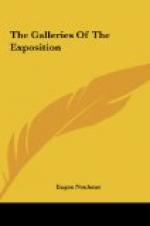The six figural compositions on the opposite wall show Whistler as concerned with design pure and simple, rather than meaning or psychological expression. They are beautiful for the fragrant looseness of their spacing of delightful, tender areas of neutralized colour, emphasized here and there by a stronger note of vermilion. Things like these express his attitude far more than any other thing he ever did. They show his understanding of the fundamentals of painting — a small part in the whole unity of beauty of which the world consists. His work as a painter is, after all, negligible in comparison with the principles he preached by his many artistic activities. His historical position, as time goes on and as his associates die, becomes more and more mystical, and even at this moment his personality has assumed an almost mythological character.
Gallery 93.
Twachtman.
It is not a far cry to Twachtman, who presents a peculiar combination of Whistlerian tonality with the methods of the modern impressionist. His work is relatively high in key, and devoid of any colour resembling black. The covered skies of early morning, before the breaking through of the sun, are his chief motives. Snow plays also an important part in his work, which is most suggestive in the tender beauty of the few values and colours it is composed of. There is absolutely nothing of the sensational about his work. To most people of not sufficient interest on first acquaintance, on better familiarity they yield to the serious student and sympathetic lover of nature unlimited pleasure. His poetry is of the true sort, and in finished work like “October”, “View on the Brette”, “Bridge in Spring”, and “Greenwich Hills”, he rises to a very high level.
Manship’s small statuettes are very effective features of this gallery. Their linear decorative architectural quality has put Manship into the front rank of our younger men, and he will have no trouble to maintain his place.
Gallery 89.
Tarbell.
In an adjoining gallery, Edmund Tarbell is much more striking, in a number of canvases containing certain qualities, which easily account for the great popularity he justly enjoys as one of the best of our American painters. To the student of pictures who does not care whether they are well painted or not, they are intensely interesting subjects, reflecting the happy domestic atmosphere of the painter’s home, which has furnished him for years inexhaustible material for many delightful interpretations of similar subjects. This ability to produce so many things of equal excellence in a relatively small circle, in one way proves his greatness. In the last analysis, he has practically everything in his work one looks for in a work of art. In addition to having an easily understood idea, his pictures are well composed, without showing the consciousness of it, as does Whistler. Fine in colour and handling,




